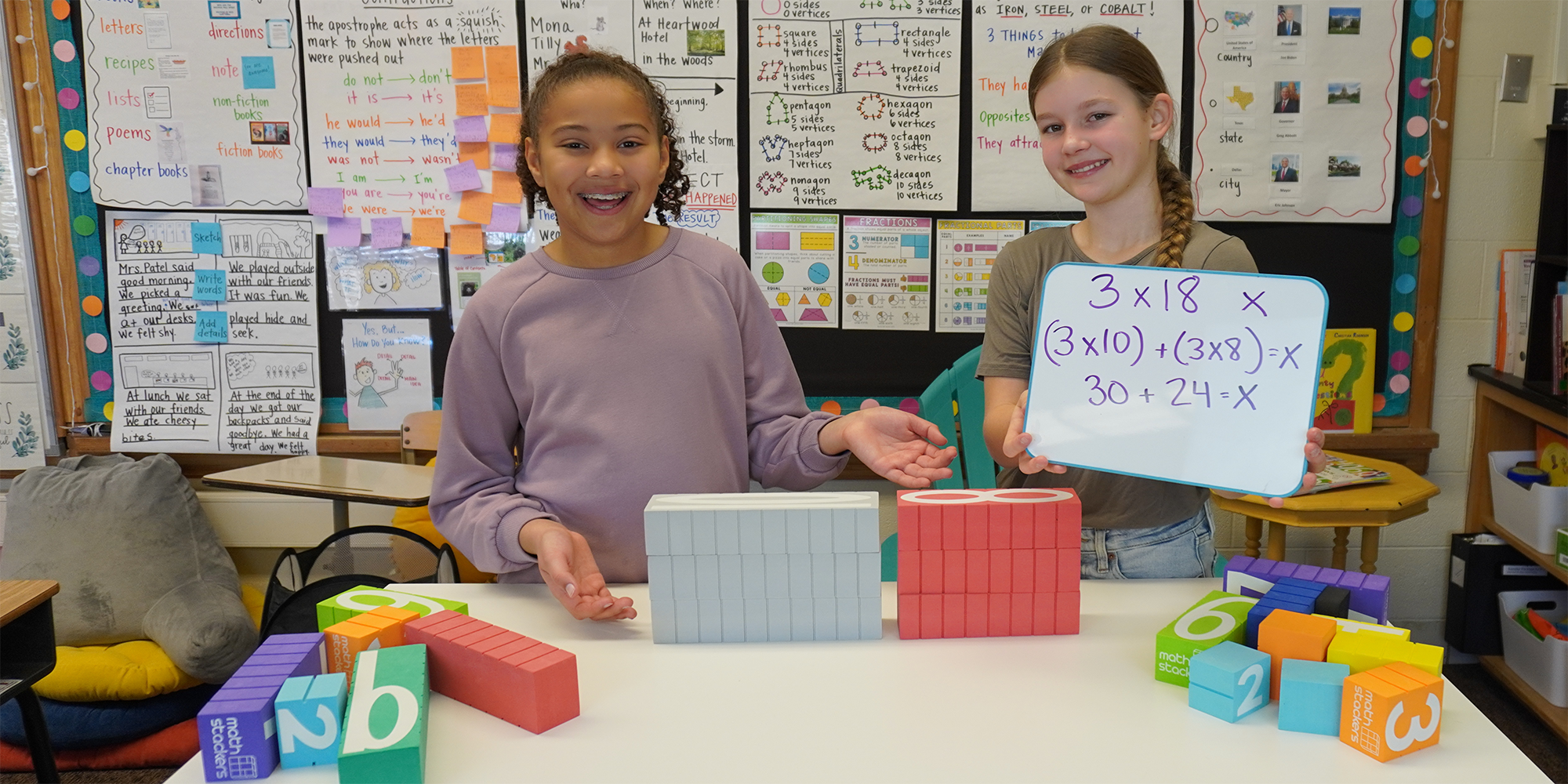*Click above to view standards for 4th grade addition & subtraction, multiplication, & fractions.
TEKS: ADDITION, SUBTRACTION, & DATA ANALYSIS
4.1 Mathematical process standards. The student uses mathematical processes to acquire and demonstrate mathematical understanding. The student is expected to
- A. Apply mathematics to problems arising in everyday life, society, and the workplace;
- B. Use a problem-solving model that incorporates analyzing given information, formulating a plan or strategy, determining a solution, justifying the solution, and evaluating the problem-solving process and the reasonableness of the solution;
- C. Select tools, including real objects, manipulatives, paper and pencil, and technology as appropriate, and techniques, including mental math, estimation, and number sense as appropriate, to solve problems;
- D. Communicate mathematical ideas, reasoning, and their implications using multiple representations, including symbols, diagrams, graphs, and language as appropriate;
- E. Create and use representations to organize, record, and communicate mathematical ideas;
- F. Analyze mathematical relationships to connect and communicate mathematical ideas;
- G. Display, explain, and justify mathematical ideas and arguments using precise mathematical language in written or oral communication.
4.5 Algebraic reasoning. The student applies mathematical process standards to develop concepts of expressions and equations. The student is expected to:
- A. Represent multi-step problems involving the four operations with whole numbers using strip diagrams and equations with a letter standing for the unknown quantity.
COMMON CORE: ADDITION, SUBTRACTION, MEASUREMENT & DATA
Operations & Algebraic Thinking:
Use the four operations with whole numbers to solve problems.
- 4.OA.A.3 Solve multistep word problems posed with whole numbers and having whole-number answers using the four operations, including problems in which remainders must be interpreted. Represent these problems using equations with a letter standing for the unknown quantity. Assess the reasonableness of answers using mental computation and estimation strategies including rounding.
TEKS: MULTIPLICATION
4.1 Mathematical process standards. The student uses mathematical processes to acquire and demonstrate mathematical understanding. The student is expected to:
- A. Apply mathematics to problems arising in everyday life, society, and the workplace;
- B. Use a problem-solving model that incorporates analyzing given information, formulating a plan or strategy, determining a solution, justifying the solution, and evaluating the problem-solving process and the reasonableness of the solution;
- C. Select tools, including real objects, manipulatives, paper and pencil, and technology as appropriate, and techniques, including mental math, estimation, and number sense as appropriate, to solve problems;
- D. Communicate mathematical ideas, reasoning, and their implications using multiple representations, including symbols, diagrams, graphs, and language as appropriate;
- E. Create and use representations to organize, record, and communicate mathematical ideas;
- F. Analyze mathematical relationships to connect and communicate mathematical ideas;
- G. Display, explain, and justify mathematical ideas and arguments using precise mathematical language in written or oral communication.
4.4 Number and operations. The student applies mathematical process standards to develop and use strategies and methods for whole number computations and decimal sums and differences in order to solve problems with efficiency and accuracy. The student is expected to:
- C. Represent the product of 2 two-digit numbers using arrays, area models, or equations, including perfect squares through 15 by 15;
- D. Use strategies and algorithms, including the standard algorithm, to multiply up to a four-digit number by a one-digit number and to multiply a two-digit number by a two-digit number. Strategies may include mental math, partial products, and the commutative, associative, and distributive properties;
- E. Represent the quotient of up to a four-digit whole number divided by a one-digit whole number using arrays, area models, or equations;
- H. Solve with fluency one- and two-step problems involving multiplication and division, including interpreting remainders.
4.5 Algebraic reasoning. The student applies mathematical process standards to develop concepts of expressions and equations. The student is expected to:
- A. Represent multi-step problems involving the four operations with whole numbers using strip diagrams and equations with a letter standing for the unknown quantity;
- D. Solve problems related to perimeter and area of rectangles where dimensions are whole numbers.
COMMON CORE: MULTIPLICATION
Operations & Algebraic Thinking:
Use the four operations with whole numbers to solve problems.
- 4.OA.A.1 Interpret a multiplication equation as a comparison, e.g., interpret 35 = 5 × 7 as a statement that 35 is 5 times as many as 7 and 7 times as many as 5. Represent verbal statements of multiplicative comparisons as multiplication equations.
- 4.OA.A.2 Multiply or divide to solve word problems involving multiplicative comparison, e.g., by using drawings and equations with a symbol for the unknown number to represent the problem, distinguishing multiplicative comparison from additive comparison.
- 4.OA.A.3 Solve multistep word problems posed with whole numbers and having whole-number answers using the four operations, including problems in which remainders must be interpreted. Represent these problems using equations with a letter standing for the unknown quantity. Assess the reasonableness of answers using mental computation and estimation strategies including rounding.
Gain familiarity with factors and multiples.
- 4.OA.B.A Find all factor pairs for a whole number in the range 1-100. Recognize that a whole number is a multiple of each of its factors. Determine whether a given whole number in the range 1100 is a multiple of a given one-digit number. Determine whether a given whole number in the range 1100 is prime or composite.
Number & Operations in Base Ten
Use place value understanding and properties of operations to perform multi-digit arithmetic.
- 4.NBT.B.5 Multiply a whole number of up to four digits by a one-digit whole number, and multiply two two-digit numbers, using strategies based on place value and the properties of operations. Illustrate and explain the calculation by using equations, rectangular arrays, and/or area models.
- 4.NBT.B.6 Find whole-number quotients and remainders with up to four-digit dividends and one-digit divisors, using strategies based on place value, the properties of operations, and/or the relationship between multiplication and division. Illustrate and explain the calculation by using equations, rectangular arrays, and/or area models.
TEKS: FRACTIONS
4.1 Mathematical process standards. The student uses mathematical processes to acquire and demonstrate mathematical understanding. The student is expected to:
- A. Apply mathematics to problems arising in everyday life, society, and the workplace;
- B. Use a problem-solving model that incorporates analyzing given information, formulating a plan or strategy, determining a solution, justifying the solution, and evaluating the problem-solving process and the reasonableness of the solution;
- C. Select tools, including real objects, manipulatives, paper and pencil, and technology as appropriate, and techniques, including mental math, estimation, and number sense as appropriate, to solve problems;
- D. Communicate mathematical ideas, reasoning, and their implications using multiple representations, including symbols, diagrams, graphs, and language as appropriate;
- E. Create and use representations to organize, record, and communicate mathematical ideas;
- F. Analyze mathematical relationships to connect and communicate mathematical ideas;
- G. Display, explain, and justify mathematical ideas and arguments using precise mathematical language in written or oral communication.
4.3 Number and operations. The student applies mathematical process standards to represent and generate fractions to solve problems. The student is expected to:
- A. Represent a fraction a/b as a sum of fractions 1/b, where a and b are whole numbers and b > 0, including when a > b; Supporting Standard;
- B. Decompose a fraction in more than one way into a sum of fractions with the same denominator using concrete and pictorial models and recording results with symbolic representations; Supporting Standard;
- C. Determine if two given fractions are equivalent using a variety of methods; Supporting Standard;
- D. Compare two fractions with different numerators and different denominators and represent the comparison using the symbols >, =, or <; Readiness Standard.
- E. Represent and solve addition and subtraction of fractions with equal denominators using objects and pictorial models that build to the number line and properties of operations;
- F. Evaluate the reasonableness of sums and differences of fractions using benchmark fractions 0, 1/4, 1/2, 3/4, and 1, referring to the same whole.
COMMON CORE: FRACTIONS
Number & Operations Fractions:
Extend understanding of fraction equivalence and ordering.
- 4.NF.A.1 Explain why a fraction a/b is equivalent to a fraction (n × a)/(n × b) by using visual fraction models, with attention to how the number and size of the parts differ even though the two fractions themselves are the same size. Use this principle to recognize and generate equivalent fractions.
- 4.NF.A.2 Compare two fractions with different numerators and different denominators, e.g., by creating common denominators or numerators, or by comparing to a benchmark fraction such as 1/2. Recognize that comparisons are valid only when the two fractions refer to the same whole. Record the results of comparisons with symbols >, =, or <, and justify the conclusions, e.g., by using a visual fraction model.
Build fractions from unit fractions.
- 4.NF.B.3 Understand a fraction a/b with a > 1 as a sum of fractions 1/b.
- 4.NF.B.3.A Understand addition and subtraction of fractions as joining and separating parts referring to the same whole.
- 4.NF.B.3.B Decompose a fraction into a sum of fractions with the same denominator in more than one way, recording each decomposition by an equation. Justify decompositions, e.g., by using a visual fraction model. Examples: 3/8 = 1/8 + 1/8 + 1/8 ; 3/8 = 1/8 + 2/8 ; 2 1/8 = 1 + 1 + 1/8 = 8/8 + 8/8 + 1/8.
- 4.NF.B.3.C Add and subtract mixed numbers with like denominators, e.g., by replacing each mixed number with an equivalent fraction, and/or by using properties of operations and the relationship between addition and subtraction.
- 4.NF.B.3.D Solve word problems involving addition and subtraction of fractions referring to the same whole and having like denominators, e.g., by using visual fraction models and equations to represent the problem.
- 4.NF.B.4. Apply and extend previous understandings of multiplication to multiply a fraction by a whole number.
- 4.NF.B.4.A Understand a fraction a/b as a multiple of 1/b. For example, use a visual fraction model to represent 5/4 as the product 5 × (1/4), recording the conclusion by the equation 5/4 = 5 × (1/4).
- 4.NF.B.4.B Understand a multiple of a/b as a multiple of 1/b, and use this understanding to multiply a fraction by a whole number. For example, use a visual fraction model to express 3 × (2/5) as 6 × (1/5), recognizing this product as 6/5. (In general, n × (a/b) = (n × a)/b.)
- 4.NF.B.4.C Solve word problems involving multiplication of a fraction by a whole number, e.g., by using visual fraction models and equations to represent the problem. For example, if each person at a party will eat 3/8 of a pound of roast beef, and there will be 5 people at the party, how many pounds of roast beef will be needed? Between what two whole numbers does your answer lie?


















